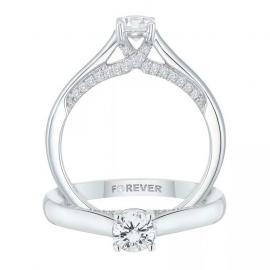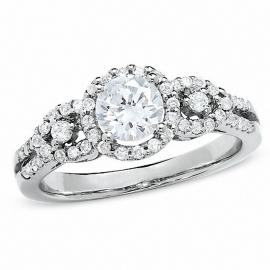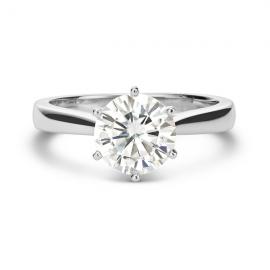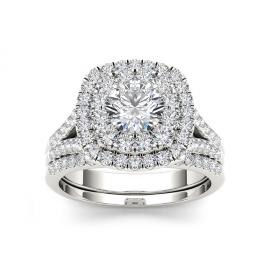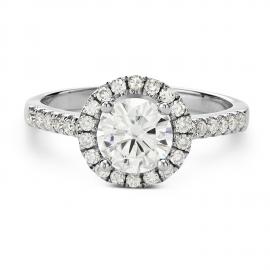Hot Jewelry Brands
Featured deals for Diamond Rings, Engagement Rings and other Jewelry
18ct White Gold 1/2ct Forever Diamond Ring - £1154.10
H.Samuel has been a much loved jeweller and one of the favourite high street Jeweller in UK. This diamond ring is currently on sale. It was sold at £2599. Now the price is £1163.1. Then use the £15 off voucher code to get another £15 off. In the end, you need only to pay £1154.10 for the beautiful 1/2 ct Forever Diamond Ring. And enjoy free next day delivery.
Birthstone: April Brand: The Forever Diamond
Diamond: 1/2 carat Material: 18ct White Gold
Stone setting: Claw Stone style: Solitaire
Stone type: Diamond
$2799.3 - 1 CT. T.W. Three Stone Framed Diamond Engagement Ring in 14K White Gold (Was $3999)
A diamond for your past, a diamond celebrating the present and a diamond symbolizing your anticipated future together-- surprise the one you love with a glittering three stone ring. Displaying unsurpassed beauty, round diamonds frame the center stones and line the double shank as they shine brightly within a 14K white gold setting. Ask for her hand in marriage or celebrate your love during an anniversary with this amazing 1 ct. t.w. diamond ring.
STONE(S)
Diamond Total Weight (CT. T.W.): 1 / Center Stone T.W.: 3/4
Diamond Color: I / Diamond Clarity: I2
Lifetime Diamond Commitment: Yes / Stone Type: Diamond
Stone Color: White / Stone Shape: Round
Stone Carat Range: 1/2 to 1 / Stone Setting: 4-Prong
Setting Only: No
METAL(S)
Metal Type: Gold / Metal Color: White
Gold Karat: 14K / Rhodium: Yes
RING DESIGN
Ring Style: Three Stone / Standard Ring Size: 7.0
- Free Shipping on $40 Get Deal
$847.99 - 14k Gold 1 7/8ct DEW Round Forever Brilliant Moissanite Solitaire Ring (Was $1699)
By Charles and Colvard. Save $851 on the sparkling Moissanite White Gold Engagement Ring. If you are underbudgeted for a diamond Engagement Ring, this is a beautiful substitution. It is sure to light up the room with this glistening stone and polished finish. Crafted from 14-karat gold, this ring features a six prong setting. The moissanite is 1 7/8 carat total diamond equivalent weight. Each piece comes with a Certificate of Authenticity and Limited Lifetime Warranty ensuring that it will maintain its brilliance and fire, without ever fading or changing color.
Moissanite:
- One round cut moissanite / Moissanite color is G-H / Moissanite is prong set / Moissanite is 8 mm x 8 mm / Moissanite weighs 1 7/8 carats
Features:
- Fine jewelry engagement ring / 14k white or yellow gold options / High polish jewelry finish / Metal Weight: 4.43 grams / Band measures 2.06 mm wide / Dimensions: 8.57 mm wide x 9.13 mm long x 9.18 mm high
- Free Shipping Get Deal
De Couer 14k Gold 2ct TDW White Diamond Halo Bridal Set from $1999 ($8,139)
If your bride is an antique fancier or a romanticist, this is one of your best choices. Enjoy over 60% off original price. This sumptuous bridal set is crafted in your choice of 14-karat white, rose, or yellow gold. The engagement ring features a 3/4 carat, round white diamond, prong set in a cushion-shaped, double halo of white diamonds. More diamonds line the split shank and the coordinating wedding band, completing the shimmering elegance of this beautiful set.
Center Diamond:
- Round cut / Prong setting / H-I color / I2-I3 clairty / Weighs 3/4 carat /
Side and Band Diamonds:
- 82 diamonds / Round cut / Prong setting / H-I color / I2-I3 clairty / Weighs 1 1/4 carats
Other Features:
- Made from 14k white, rose, or yellow gold / High polish finish / Halo style / Ring setting is 21mm wide x 28.65mm long x 5.1mm high / Band is 3.65 mm wide
- $6,139.01 off original price Get Deal
Charles & Colvard 14k Gold 1.3-carat Round Moissanite Halo Engagement Ring only $559.99
Save $440 (second round, discount goes higher). Similar Item recommended price is $999.99. If you join the Club O which is $19.95/yr, you will get another 5% rewards, which is on this case $28. Only 3 left now. Grab the offer before it's gone.
Moissanite:
- Round main gemstone weighs (DEW) 1 carat
- Main gemstone measures 6.5 mm wide x 6.5 mm long
- Each accent gemstones weigh (DEW) .01 carat
- Accent gemstones measure 1.3mm wide x 1.3 mm long
- 30 total accent gemstones
- Total gemstone weight is 1.3 carats
- Primary gemstone is G-H-I near-colorless
- Prong settings
- 14-karat White Gold:
- Weighs 2.55 grams
- High polish finish
- Band measures 1.52 mm wide
- Ring is 6.54 mm wide x 6.47 mm long x 6.70 mm high
- Free Shipping Get Deal
Something about Diamond, Something about PromoPro
 “Diamonds are a Girl’s Best Friend”, as sung by Marilyn Monroe. No girl could ever resist a sparkling diamond. The square-cut or pearl-shaped rocks never loose their shape.
“Diamonds are a Girl’s Best Friend”, as sung by Marilyn Monroe. No girl could ever resist a sparkling diamond. The square-cut or pearl-shaped rocks never loose their shape.
Diamonds have been known to mankind and used as decorative items since ancient times; some of the earliest references can be traced to India. From the Ancient Greek, it means “unbreakable”, “proper” or “unalterable”. No girl could ever resist a sparkling diamond.
So how to buy theright loose diamond? To grade and certify diamonds, “4-Cs” have been created,which are Cut, Color, Clarity and Carat, lined in the order of importance.After understanding the four Cs, you can start to look for your own perfect diamond.
Cut
The cut of a diamonddescribes the quality of workmanship and the angles to which a diamond is cut. Itis the most important of the 4Cs because it has the greatest influence on adiamond's sparkle. Even if a diamond has a perfect clarity and color grade, ifit has a poor cut, it may appear dull. When a diamond is cut with the properproportions, light is returned out of the top of the diamond (which gemologistsrefer to as the table). If it is cut too shallow, light leaks out of thebottom; too deep and it escapes out of the side.

Diamond cut can be classified into 5grades.
- Super Ideal / True Hearts: True Heart Diamond is cut to gather andreflect the most light possible. Light performance is measured by threefactors: brilliance, fire and sparkle. Fewer than 15 out of every 10,000diamonds qualify as an true heart diamond.
- Ideal: This rare cut represents roughly the top 3% of diamond cutquality. It reflects most light that enters the diamond.
- Very Good: This cut represents roughly the top 15% of diamond cutquality. It reflects nearly as much light as the ideal cut, but for a lowerprice.
- Good: This cut represents roughly the top 25% of diamond cutquality. It reflects most light that enters, but not as much as a Very Good cutgrade.
- Poor/Fair Cut: Represents roughly the top 35% of diamond cutquality. These diamonds tend to appear dull or glassy. Most online loosediamond suppliers do not offer poor cut diamond.
Color
Diamonds come naturally in every color of the rainbow. However most people are concerned with diamonds which are basically transparent with little tint or white diamonds. The Gemological Institute of America (GIA) rates the body color in white diamonds from D (colorless) to Z (light yellow).

- Colorless: D, E,F
- Near Colorless: G, H, I,J
- Faint Yellow: K, L, M
- Very Light Yellow: N,O, P, Q, R
- Light Yellow: S, T, U, V, W, X, Y, Z
Clarity
Most diamonds contain very tiny birthmarks known as "inclusions." An inclusion can interfere with the light passing through the diamond. The fewer the inclusions, the more beautiful the diamond will be and the higher the clarity grade. Diamond clarity is often the least important of the 4Cs because most inclusions are microscopic; they don’t affect the diamond’s beauty in a visible way.

- FL, IF: Flawless, Internally Flawless. Under 10x magnification, inclusions are not visible, rarest clarity grade.
FL: No visible blemishes, <1% of diamonds
IF: Very slight blemishes, <3% of diamonds - VVS1, VVS2: Very, Very Slightly Included. Characteristics minisculeand difficult to see under 10x magnification, even to a trained eye.
VVS1: Few miniscule inclusions
VVS2: Slightly more miniscule inclusions - VS1, VS2: Very Slightly Included. Minor inclusions ranging fromdifficult to somewhat easy to see at 10x magnification.
VS1: Difficult to see minor inclusions
VS2: Somewhat easier to see minor inclusions - SI1, SI2: Slightly Included. Inclusions noticeable at 10x. Bestvalue. SI2 inclusions may be detectable to a discerning unaided eye.
SI1: Inclusions occasionally visible to the keen eye withoutmagnification
SI2: Inclusions typically visible from the pavilion, and often seenfrom the top, without magnification - I1, I2, I3: Included. Inclusions are obvious under 10xmagnification, usually visible to the unaided eye.
Carat
This is the weight of a diamond measured in carats. As the carat weight of a diamond increases so does its rarity and therefore its price. One carat is divided into 100 "points," so that a diamond of 75 points weights .75 carats. The carat-weight of a diamond is the easiest measurement to determine. Most importantly, two diamonds can be of equal carat-weight, but their value can differ greatly due to their cut, color, and clarity.
Shape
Besides the most famous 4 Cs, Shape is also an important aspect, as the shape generates the most direct visual impact.
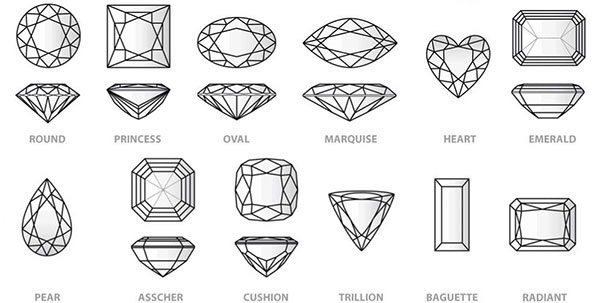
If you know exactly which shape you like and which grade of diamond you want, we recommend you to buy loose diamond. This way is more cost wise. If not, do not worry either. Most online Jewelry retailers offer their own designs or featured collections.
PromoPro.com displays for you the most up-to-date diamond coupons and deals. Our editors hand-pick the best-seller Jewelry which can be purchased with the max discount from well-known Jewelry Brands, including but not limited to BlueNile, Diamonds International, James Allen, WatchShop.com and so on. No matter you are looking for engagement rings, or earrings, pendants, diamond watched or just loose diamond, look through our page, you will find the one you love.
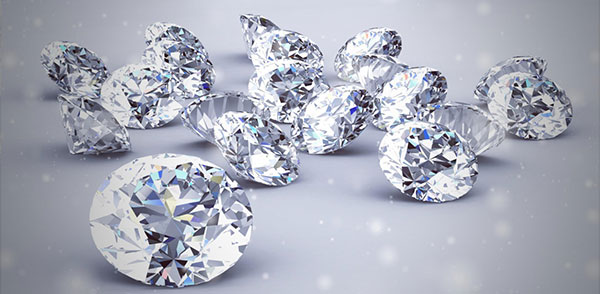
Reference:
1. Wikipedia: https://en.wikipedia.org/wiki/Diamond_(gemstone)#Gemological_characteristics
2. BlueNile Diamonds: https://www.bluenile.com/education/diamonds






